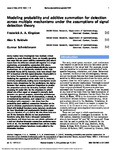Modeling probability and additive summation for detection across multiple mechanisms under the assumptions of signal detection theory
| dc.contributor.author | Kingdom, FAA | |
| dc.contributor.author | Baldwin, AS | |
| dc.contributor.author | KANG, JUNGHEE | |
| dc.date.accessioned | 2017-11-16T17:36:54Z | |
| dc.date.available | 2017-11-16T17:36:54Z | |
| dc.date.issued | 2015-04-10 | |
| dc.identifier.issn | 1534-7362 | |
| dc.identifier.issn | 1534-7362 | |
| dc.identifier.other | ARTN 1 | |
| dc.identifier.uri | http://hdl.handle.net/10026.1/10192 | |
| dc.description.abstract |
Many studies have investigated how multiple stimuli combine to reach threshold. There are broadly speaking two ways this can occur: additive summation (AS) where inputs from the different stimuli add together in a single mechanism, or probability summation (PS) where different stimuli are detected independently by separate mechanisms. PS is traditionally modeled under high threshold theory (HTT); however, tests have shown that HTT is incorrect and that signal detection theory (SDT) is the better framework for modeling summation. Modeling the equivalent of PS under SDT is, however, relatively complicated, leading many investigators to use Monte Carlo simulations for the predictions. We derive formulas that employ numerical integration to predict the proportion correct for detecting multiple stimuli assuming PS under SDT, for the situations in which stimuli are either equal or unequal in strength. Both formulas are general purpose, calculating performance for forced-choice tasks with M alternatives, n stimuli, in Q monitored mechanisms, each subject to a non-linear transducer with exponent τ. We show how the probability (and additive) summation formulas can be used to simulate psychometric functions, which when fitted with Weibull functions make signature predictions for how thresholds and psychometric function slopes vary as a function of τ, n, and Q. We also show how one can fit the formulas directly to real psychometric functions using data from a binocular summation experiment, and show how one can obtain estimates of τ and test whether binocular summation conforms more to PS or AS. The methods described here can be readily applied using software functions newly added to the Palamedes toolbox. | |
| dc.format.extent | 1-1 | |
| dc.format.medium | ||
| dc.language | en | |
| dc.language.iso | eng | |
| dc.publisher | Association for Research in Vision and Ophthalmology (ARVO) | |
| dc.subject | probability summation | |
| dc.subject | signal detection theory | |
| dc.subject | high threshold theory | |
| dc.subject | visual detection | |
| dc.title | Modeling probability and additive summation for detection across multiple mechanisms under the assumptions of signal detection theory | |
| dc.type | journal-article | |
| dc.type | Journal Article | |
| dc.type | Research Support, Non-U.S. Gov't | |
| plymouth.author-url | https://www.webofscience.com/api/gateway?GWVersion=2&SrcApp=PARTNER_APP&SrcAuth=LinksAMR&KeyUT=WOS:000355203800001&DestLinkType=FullRecord&DestApp=ALL_WOS&UsrCustomerID=11bb513d99f797142bcfeffcc58ea008 | |
| plymouth.issue | 5 | |
| plymouth.volume | 15 | |
| plymouth.publication-status | Published | |
| plymouth.journal | Journal of Vision | |
| dc.identifier.doi | 10.1167/15.5.1 | |
| plymouth.organisational-group | /Plymouth | |
| plymouth.organisational-group | /Plymouth/Faculty of Health | |
| plymouth.organisational-group | /Plymouth/Faculty of Health/School of Health Professions | |
| plymouth.organisational-group | /Plymouth/REF 2021 Researchers by UoA | |
| plymouth.organisational-group | /Plymouth/REF 2021 Researchers by UoA/UoA03 Allied Health Professions, Dentistry, Nursing and Pharmacy | |
| plymouth.organisational-group | /Plymouth/Research Groups | |
| plymouth.organisational-group | /Plymouth/Research Groups/Institute of Health and Community | |
| plymouth.organisational-group | /Plymouth/Users by role | |
| plymouth.organisational-group | /Plymouth/Users by role/Academics | |
| dc.publisher.place | United States | |
| dc.identifier.eissn | 1534-7362 | |
| dc.rights.embargoperiod | Not known | |
| rioxxterms.versionofrecord | 10.1167/15.5.1 | |
| rioxxterms.licenseref.uri | http://www.rioxx.net/licenses/all-rights-reserved | |
| rioxxterms.type | Journal Article/Review |


